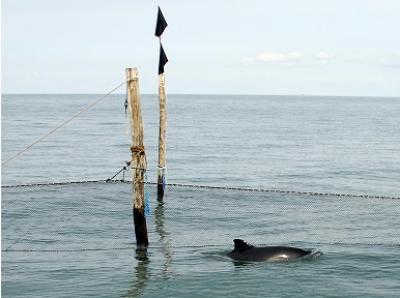How Killer Whales Boosted Porpoise Echolocation

Busy coastal waters can be fatally seductive for whales; fish are plentiful, and so are the nets of fishermen.
But the smallest of the cetaceans, harbor porpoises, have sharp echolocation skills that help them distinguish tiny meals from tiny net floats in today's crowded marine environments.
The stout mammals use shorter, higher-frequency sonar clicks than many other toothed whales. These biosonar beams bounce off underwater objects and send back a faint echo, which the porpoises interpret to determine the location and shape of small obstacles and treats alike.
A new study argues that harbor porpoises can thank their mortal enemies, killer whales, for the refined echolocation ability that helps them survive in today's human-tainted seascapes. Harbor porpoises likely evolved high-frequency clicks as something like a secret language to elude predatory orcas, researchers say.
"Over millions of years the porpoise has evolved its ability to emit very high frequency click sounds that killer whales have difficulty hearing since they cannot hear sounds that are much higher than about 100 kHz," study researcher Lee Miller, of the University of Southern Denmark, explained in a statement. "Killer whale hearing is best at around 20 kHz, so it is hard for them to detect a porpoise."
Echolocation is thought to have first evolved in toothed whales about 30 million years ago, and the ability kept changing in response to different threats. Killer whales may represent one such threat. They are highly intelligent and sophisticated hunters that frequently prey on other marine mammals; they've even been known to attack cetaceans as big as sperm whales.
After the killer whale entered the scene 5-10 million years ago, evolution began to favor creatures that could avoid orcas, the researchers say.
Get the world’s most fascinating discoveries delivered straight to your inbox.
"One way to avoid being eaten was to emit echolocation sounds that were difficult for killer whales to detect – thus an ability favored by evolution," Miller and fellow researcher Magnus Wahlberg said.
Each porpoise click is just a hundred-millionth of a second, at a frequency of around 130 kHz. That's far beyond the frequencies that humans (up to 20 kHz) and even dogs (up to 60 kHz) can hear.
As Miller explained, this frequency proves most effective for harbor porpoises.
"Besides avoiding killer whales, there is another advantage: It is also at these frequencies that natural noise in the ocean is the lowest," Miller explained in a statement. "Thus porpoises can better hear the echoes from objects and prey when using these clicking sounds."
The research was detailed online in the journal Frontiers in Integrative Physiology.
Follow Megan Gannon on Twitter and Google+. Follow us @livescience, Facebook & Google+. Original article on Live Science.



